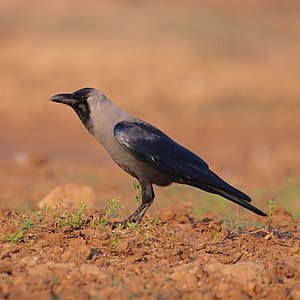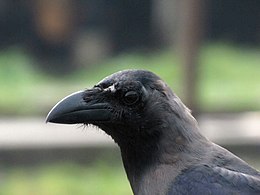Bright crow
| Bright crow | ||||||||||||
|---|---|---|---|---|---|---|---|---|---|---|---|---|

Bright crow ( Corvus splendens splendens ) in Bangalore |
||||||||||||
| Systematics | ||||||||||||
|
||||||||||||
| Scientific name | ||||||||||||
| Corvus splendens | ||||||||||||
| Vieillot , 1817 |
The house crow ( Corvus splendens ) is bird art of the genus crows and ravens ( Corvus ) from the family of corvids (Corvidae). Within the genus Corvus , it represents a slender, medium-sized species and is characterized by glossy, gray-black plumage and a long beak. Their original range is on the Indian subcontinent and in West Indochina . Since the 19th century, it has been carried away by humans on ships to Africa, Arabia , Europe, Japan and Australia, where it was able to establish itself temporarily or permanently. The brilliant crow has been associated with humans for several millennia and is only found in their vicinity today. It feeds on all available animal and vegetable food sources in its environment and is dominant and sometimes aggressive even towards larger crows.
The breeding season of the golden crow varies depending on the region. She builds her nest from twigs and often from barbed wire, clotheslines and similar objects made by humans. The clutch usually consists of four to five eggs, from which the young hatch after 16 to 17 days. The brilliant crow occurs in five subspecies and is probably systematically close to the jungle crow ( Corvus culminatus ). In many regions where it was introduced, the golden crow is considered and pursued as a pest. In this way it was exterminated in Australia, but the global population is not considered endangered due to the frequency of the species in South Asia.
features
Build and color
Compared to other ravens and crows , the glossy crow appears very slender. With a body length of 41–43 cm, the species is one of the medium-sized representatives of its genus. There is a slight sexual dimorphism , even if the dimensions of the sexes mostly overlap strongly. Males are on average larger than females and also reach larger minimum and maximum dimensions. In the field, the glossy crow can be recognized by its stature and characteristic plumage with cloudy gray and shiny black mother-of-pearl . The beak is slightly arched and relatively strong and high.
The wing length of the glossy crow is 225-290 mm for males, which corresponds to a wingspan of 76-86 cm. The tail of male birds is 147–175 mm long, their barrel bone measures 45–51 mm. The male beak becomes 49–56 mm long. Females remain clearly behind males in all maximum dimensions: their wing length is 219–264 mm, their tail measures 128–155 mm. The female barrel bone reaches a length of 44–48 mm, the beak measures between 47 and 50 mm.
The plumage of the glossy crow is characterized by a characteristic pattern of gray and black. Forehead, cheeks and throat as well as wings, back and tail are colored jet black and have a greenish, bluish or purple sheen. Outer ear covers, neck, chest and belly plumage, however, are gray. The color shade can vary between light ash gray and dark mouse gray depending on the subspecies. The beak is dark, slate gray and about half of it is covered by black nasal bristles .
distribution
Bright crows are widespread in different parts of the world today, but they only have a spacious species range in southern Eurasia . It stretches from the north coast of the Gulf of Oman across the entire Indian subcontinent to western Indochina . In East Africa this species was introduced in the area of Zanzibar and Bur Sudan . It was also introduced to Australia, but has been exterminated as far as is known.
The golden crow is often concentrated on human settlements. Away from villages and towns, it occurs much less often.
In 2016 it was included in the “List of undesirable species” for the European Union .
Occurrence in the Netherlands
The golden crow has been breeding in the Netherlands since the late 1990s . The first successful brood was found in 1997 in Hoek van Holland , a district of Rotterdam . By 2008 the population there had grown to 25 animals and from 2004 a further population established itself in The Hague . In 2012, 20 to 30 birds were counted in and around Hoek van Holland.
In 2012 the authority Nederlandse Voedselen Warenautoriteit decided to remove the glossy crows from the nature of the Netherlands, because a negative influence on other species should be prevented. De Faunabescherming , an animal welfare association, and Partij voor de Dieren took legal action against it. On January 14, 2013, the responsible judge ruled that the golden crow falls under the applicable regulations for all wild bird species in the Netherlands and must therefore not be exterminated. At most, the number of glossy crows may be limited.
Way of life
The glossy crow feeds mainly on human waste, small reptiles, insects and other invertebrates, eggs, nestlings , grains and fruits. It mostly looks for food on the ground. The species is considered to be a nest predator, which is why it is sometimes very intensively pursued in the countries that it repopulates. It is closely observed in the Netherlands, but the effects on other species are apparently small so far.
Subspecies
So far, five subspecies are known:
- Corvus splendens zugmayeri Laubmann , 1913 - This subspecies occurs in southern Iran via Pakistan to north-central India .
- Corvus splendens splendens Vieillot , 1817 - The nominate form occurs in central and southern India, in Nepal , in Bangladesh and in Bhutan .
- Corvus splendens protegatus Madarász , 1904 - The subspecies occurs in southwest India and Sri Lanka .
- Corvus splendens maledivicus Reichenow , 1904 - This subspecies is common in the Maldives .
- Corvus splendens insolens Hume , 1874 - This subspecies is common in Myanmar , southern China, and southwest Thailand .
swell
literature
- Salím Ali, S. Dillon Ripley: Handbook of the Birds of India and Pakistan. Volume 5: Larks to the Gray Hypocolius. Oxford University Press, London 1972.
- Dean Amadon: The Genera of Corvidae and their Relationships. In: American Museum Novitates 1251, January 1944. pp. 1-21.
- William Geoffrey Arnott: Birds in the Ancient World from A to Z. Routledge, 2007. ISBN 0-415-23851-X .
- Hans-Günther Bauer, Einhard Bezzel , Wolfgang Fiedler : The compendium of birds in Central Europe: Everything about biology, endangerment and protection. Volume 2: Passeriformes - passerine birds. Aula-Verlag Wiebelsheim, Wiesbaden 2005, ISBN 3-89104-648-0 .
- Stuart Keith , Emil K. Urban , C. Hilary Fry (Eds.): The Birds of Africa. Volume 6: Picathartes to Oxpeckers. Academic Press, 2000, ISBN 0-12-137301-0 .
- Stanley Cramp , CM Perrins: Handbook of the Birds of Europe, the Middle East, and North Africa: The Birds of the Western Palearctic Volume VIII: Crows to Finches. Oxford University Press, Hong Kong 1994, ISBN 0-19-854679-3 .
- Derek Goodwin : Crows of the World. 2nd Edition. The British Museum (Natural History) , London 1986, ISBN 0-565-00979-6 .
- Peter Jeffrey Higgins, John M. Peter & SJ Cowling (Eds.): Handbook of Australian, New Zealand and Antarctic Birds. Volume 7: Boatbill to Starlings . Oxford University Press, Melbourne 2006. ISBN 978-0-19-553996-7 .
- Joseph del Hoyo, Andrew Elliot, David Christie (Eds.): Handbook of the Birds of the World. Volume 14: Bush-shrikes To Old World Sparrows. Lynx Edicions, Barcelona 2009. ISBN 978-84-96553-50-7
- Steve Madge , Hilary Burn: Crows & Jays. Princeton University Press, Princeton 1994, ISBN 0-691-08883-7 .
- John M. Marzluff , Tony Angell: In the Company of Crows and Ravens . Yale University Press, New Haven and London 2005. ISBN 0-300-10076-0 .
- Colin Ryall: House Crow (Corvus splendens) . Invasive Species Compendium , www.cabi.org, 2011.
- Louis Pierre Vieillot: Nouveau Dictionnaire d'Histoire Naturelle. Tome VIII. Deterville, Paris 1817. ( Online )
Web links
- Corvus splendens in the endangered Red List species the IUCN 2008. Posted by: BirdLife International, 2008. Accessed on January 1 of 2009.
- Videos, photos and sound recordings about Corvus splendens in the Internet Bird Collection
- Feathers of the Bright Crow
Individual evidence
- ↑ Vieillot 1817 , p. 44.
- ↑ a b Cramp & Simmons 1994 , p. 143.
- ↑ Ali & Ripley 1972 , pp. 243-247.
- ↑ Higgins et al. 2006 , p. 771.
- ↑ List of Invasive Alien Species of Union Concern (PDF) accessed on July 15, 2016
- ^ Colin Ryall: The House Crow population in the Netherlands and its implications for the species' spread across the Europe. In: A. Woolnough, C. Feare, G. Meier (Eds) 2008: Proceedings of the International Invasive Bird Conference, Fremantle, Western Australia. : P. 27. Abstract as PDF ( Memento from March 26, 2012 in the Internet Archive )
- ↑ [1]
- ↑ Bauer et al., P. 76.
- ^ IOC World Bird List Crows, mudnesters & birds-of-paradise



